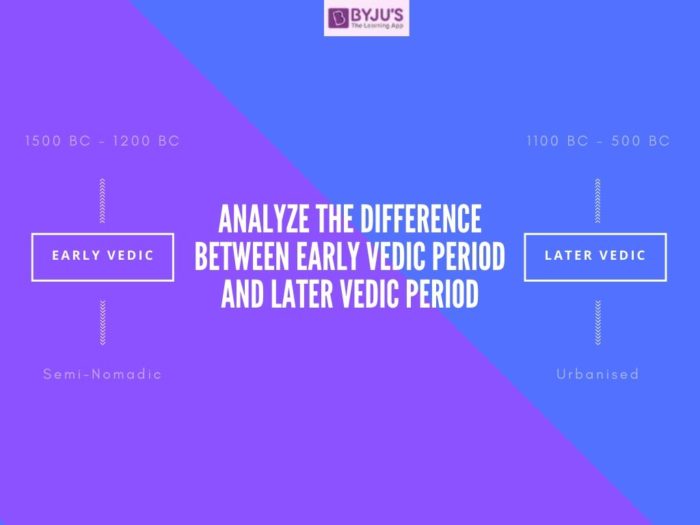The Vedic Age was a significant era in Ancient Indian History. As such, the questions from this topic have always been featured in the history segment of the UPSC Prelims.
The Vedic age itself is divided into the Early Vedic Period (1500 – 1000 BCE) and Later Vedic Period (1000 – 600 BCE)*. The reason being that society underwent drastic changes from the time the first Vedas were written to the appearance of later Vedic scriptures.

This article will provide details about the transformation of society in the Early and Later Vedic Ages for the IAS Exam.
In the table below we have given in detail the differences between the Early Vedic Period and Later Vedic Period
Differences Between Early Vedic Age and Later Vedic Age
| Early Vedic Period |
Later Vedic Period |
| The caste system was flexible and based on profession rather than birth | The caste system became more rigid in this period with birth being the main criteria |
| There was no concept of Shudra or untouchables | Shudras became a mainstay in the Later Vedic period. Their sole function was to serve those of the upper-castes |
| Women were allowed a greater degree of freedom in this period. They were allowed to participate in the political process of the time to a certain extent | Women were restricted from their participation in society by being relegated to subordinate and docile roles |
| Kingship was fluid as the kings were elected for a fixed period by the local assembly known as Samiti | As society became more urbanized in this period, the need for stable leadership was realized. Thus the absolute rule of the Kings became more and more prominent |
| Early Vedic society was pastoralist and semi-nomadic in nature | Society became more settled in nature. It became centred around agriculture in general |
| In the Early Vedic Period, the barter system was more prevalent with little to no monetary value transaction being part of the exchange | Although the barter system was still in practice, it was largely replaced by the exchange of gold and silver coins known as Krishnala |
| Rigveda. This text is cited as the earliest text from this period | Yajurveda. Samaveda
Atharvaveda |
* The dates of Early Vedic and Later Vedic Periods are sourced from NIOS.
To know more in detail about the Vedic Civilization and the Vedas from both the time periods, you can check the links given below:
You can find more Difference Between Articles, by visiting the linked page
Candidates can also check the links given below to know more about other related topics. These linked articles can help will also help UPSC Aspirant with the History segment of the exam.
Vedic LiteratureNCERT Ancient Indian History NotesNCERT Medieval Indian History Notes
| NCERT Modern Indian History Notes | Prehistoric Age of India | Varna System |
Difference Between Early Vedic period and Later Vedic Period – UPSC Notes:- Download PDF Here
Frequently Asked Questions about Early Vedic Period and Later Vedic Period
Which period is known as later Vedic period?
Why is the early Vedic period known as the Rigvedic period?
You can get a general idea of the exam by visiting the UPSC Syllabus page. For more preparation materials refer to the links given below:
Related Links
| NCERT Books | UPSC Exam Pattern | Current Affairs Quiz |
| Albedo of Earth | Lord Minto | GPSC Recruitment |
| Current Affairs | Black Soil in India | Mauryan Empire |
Comments